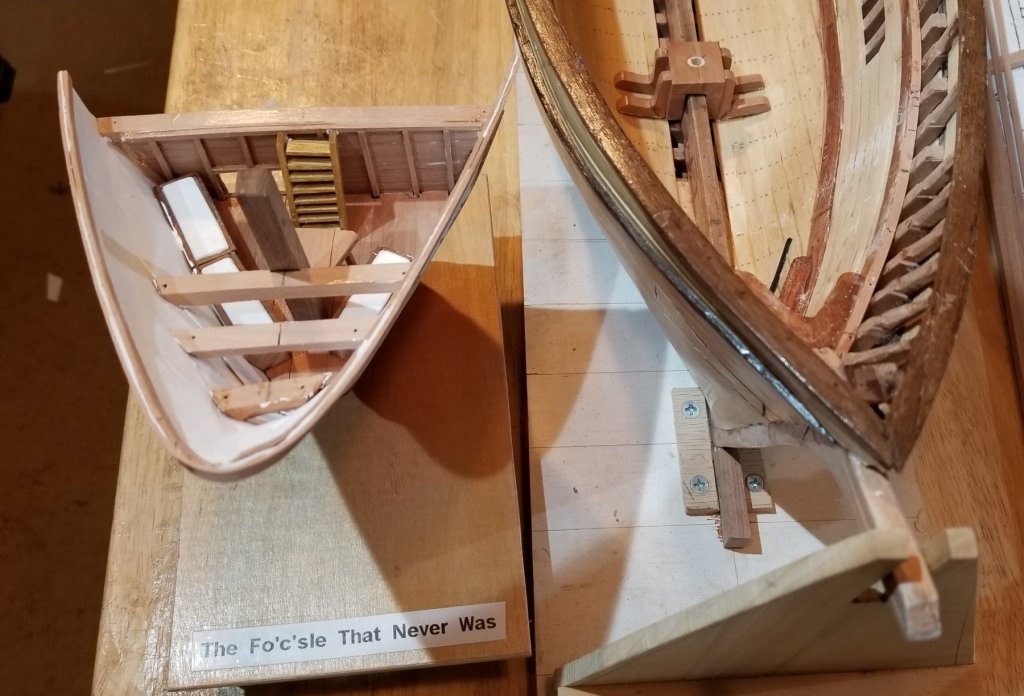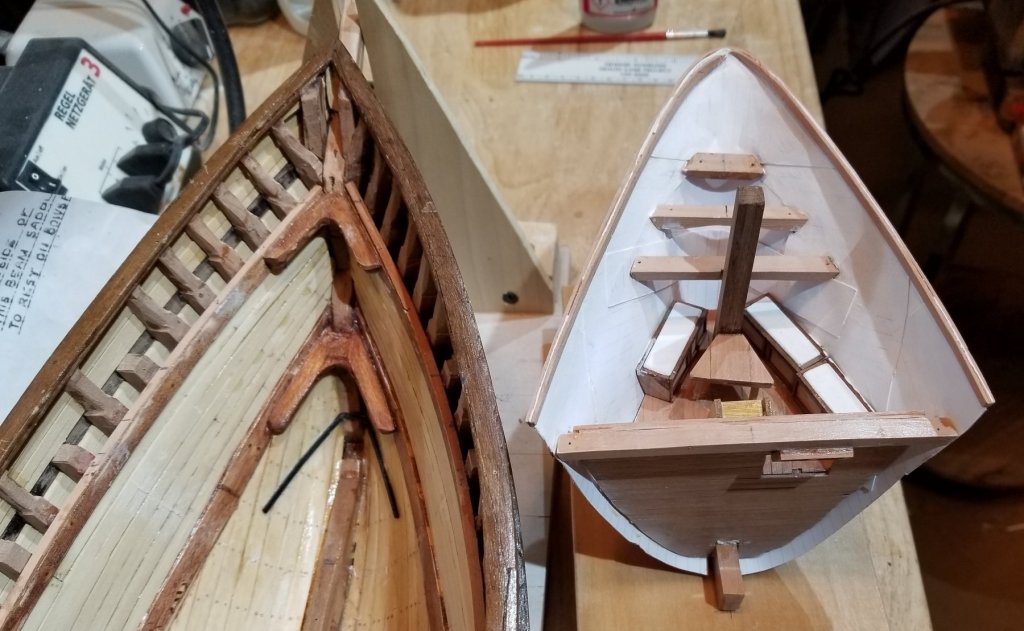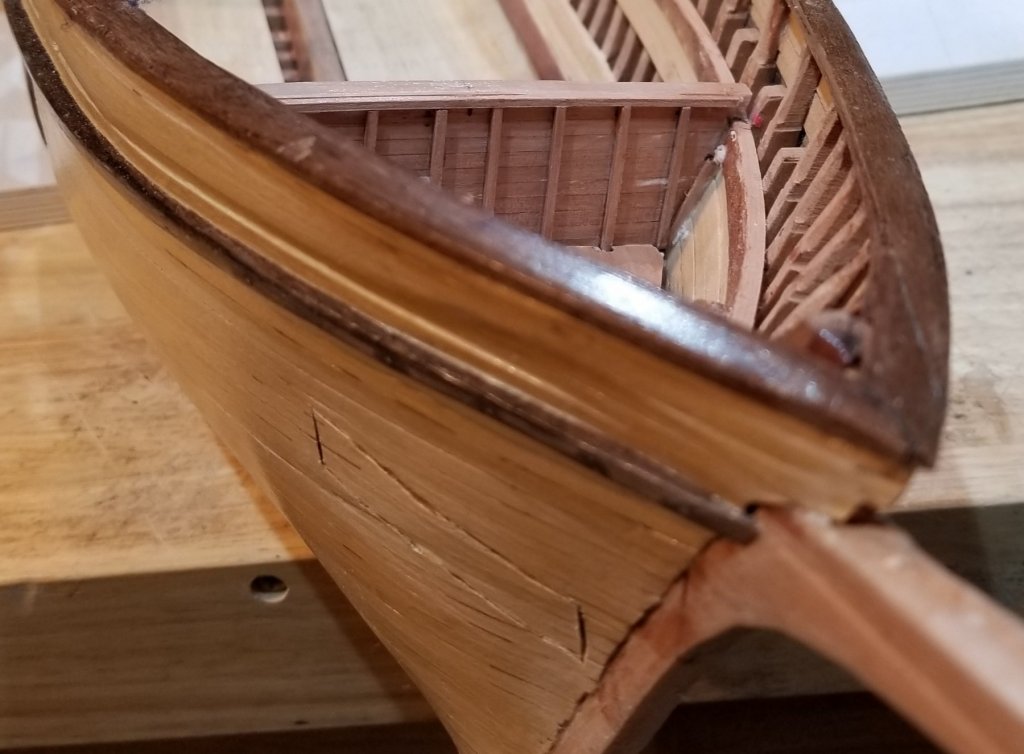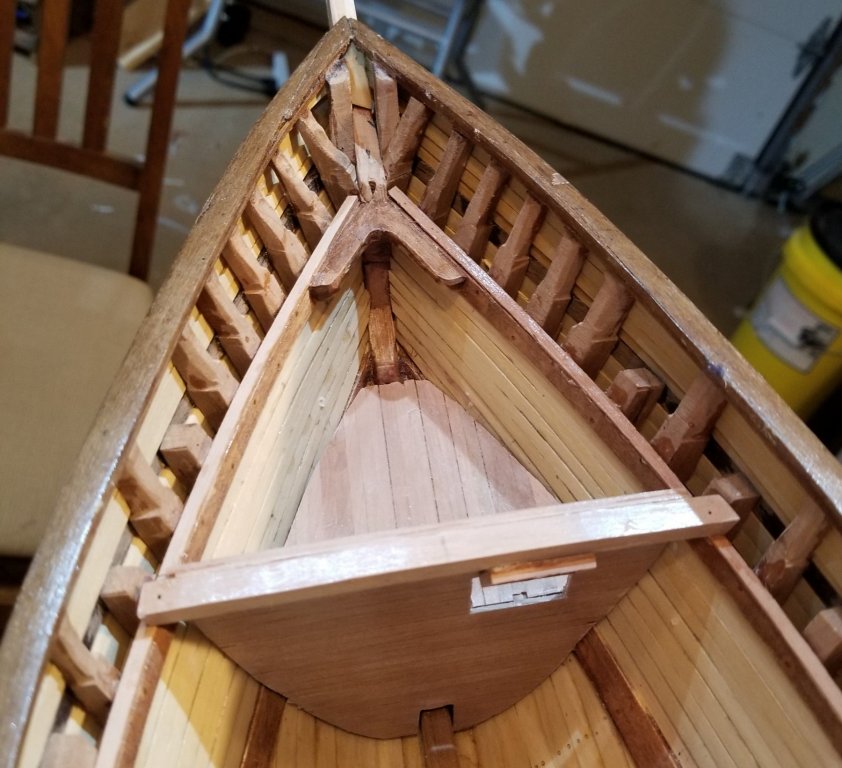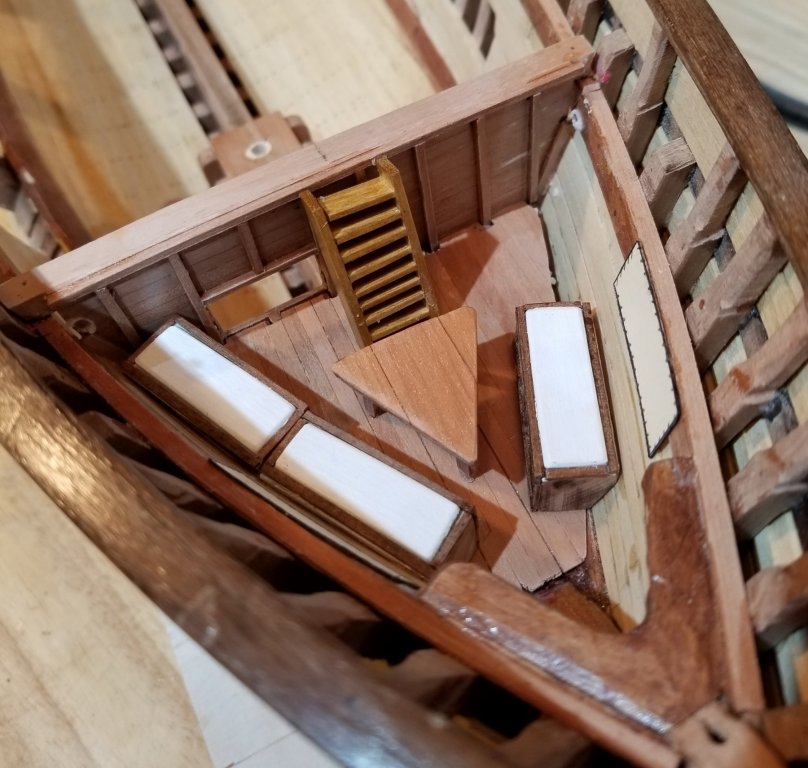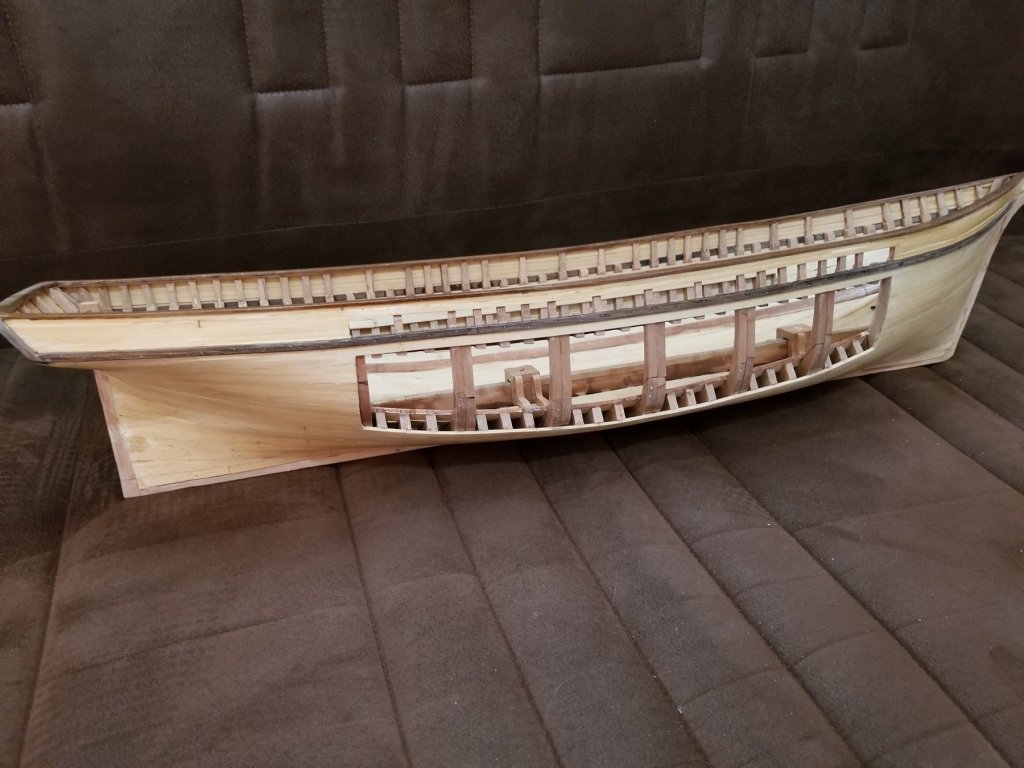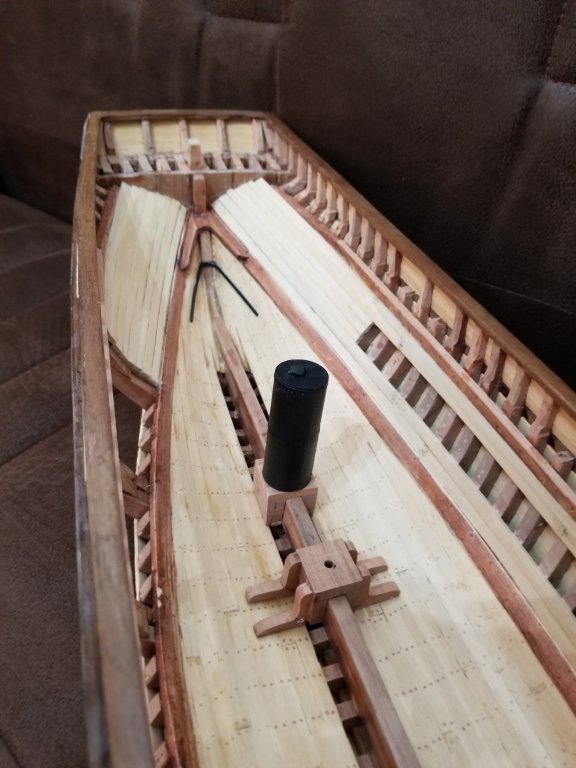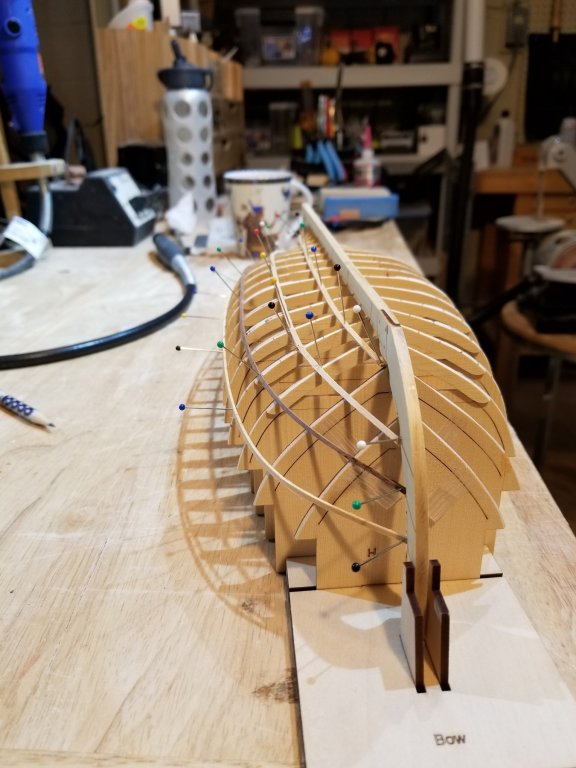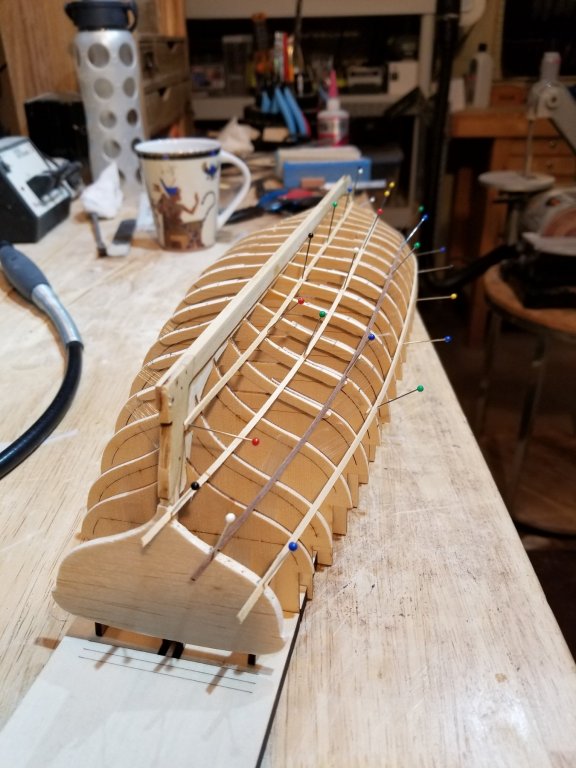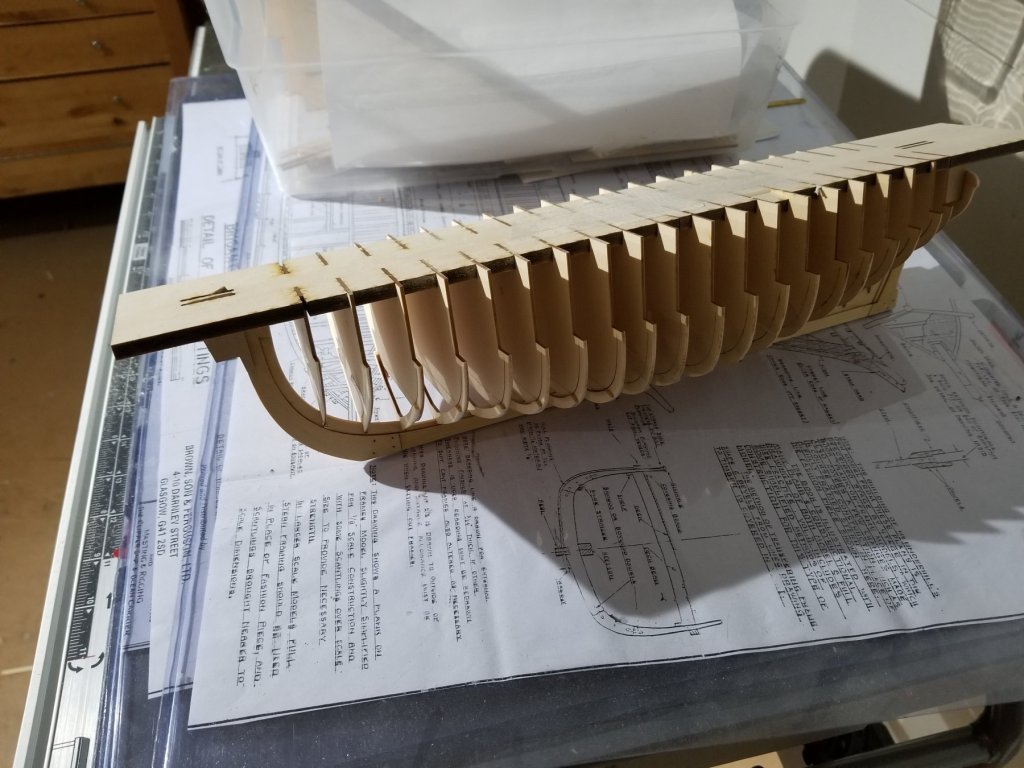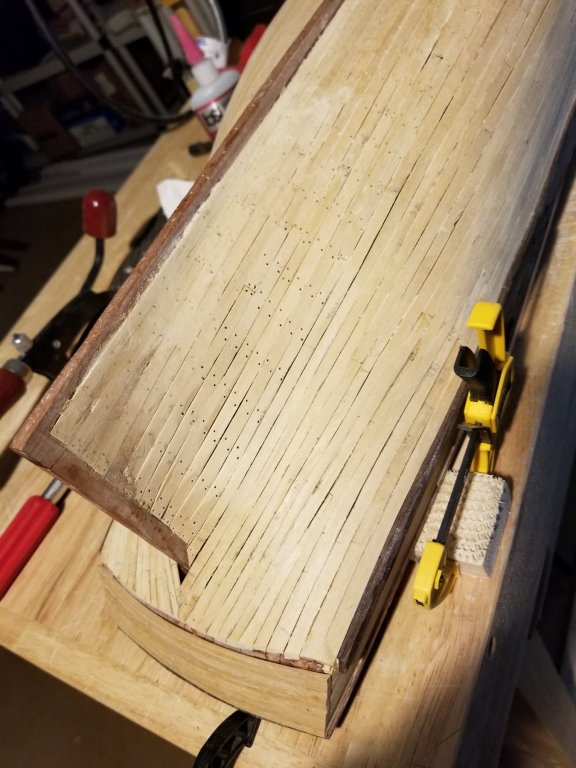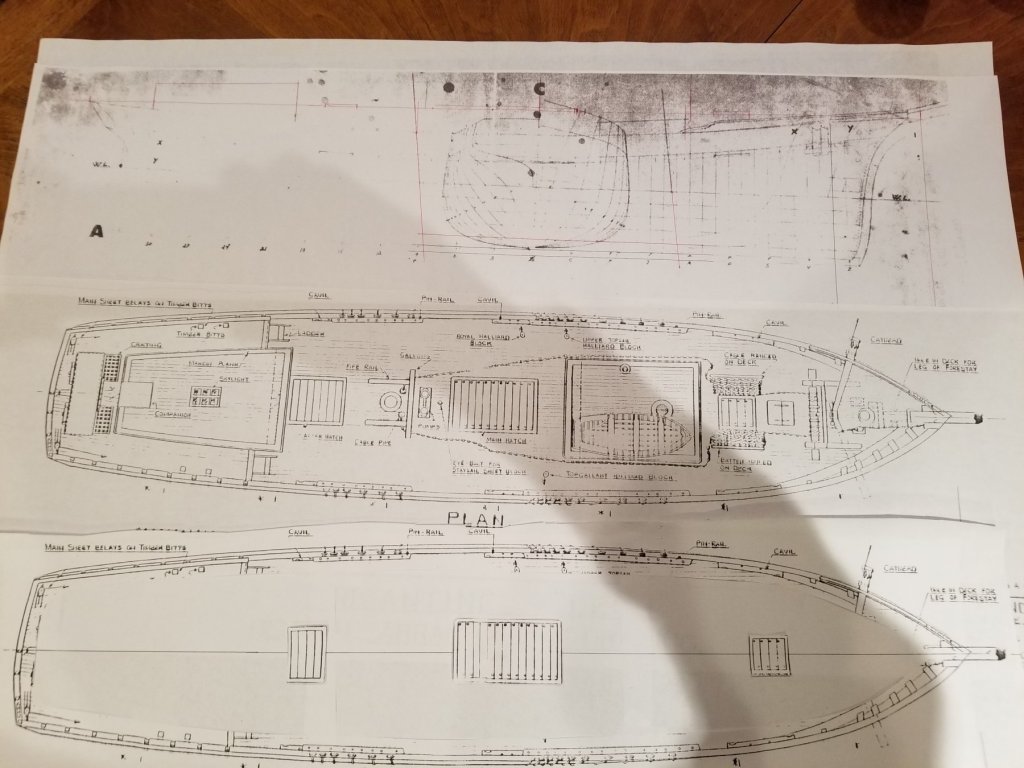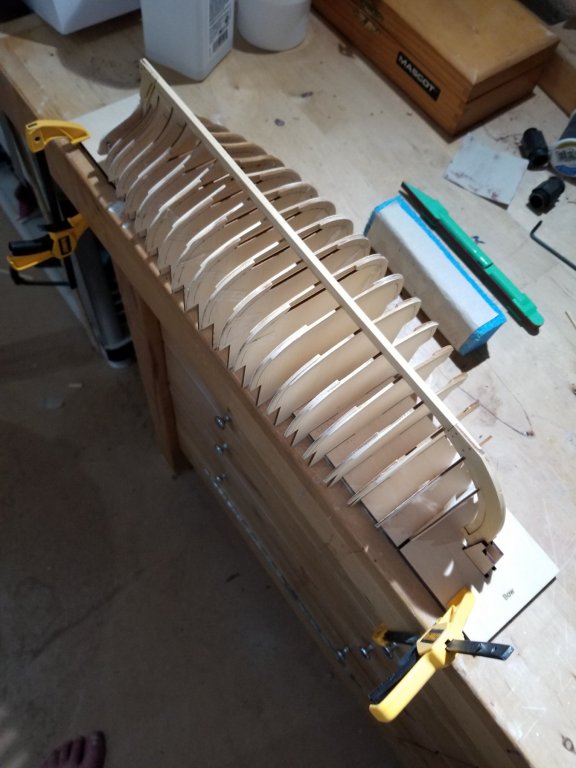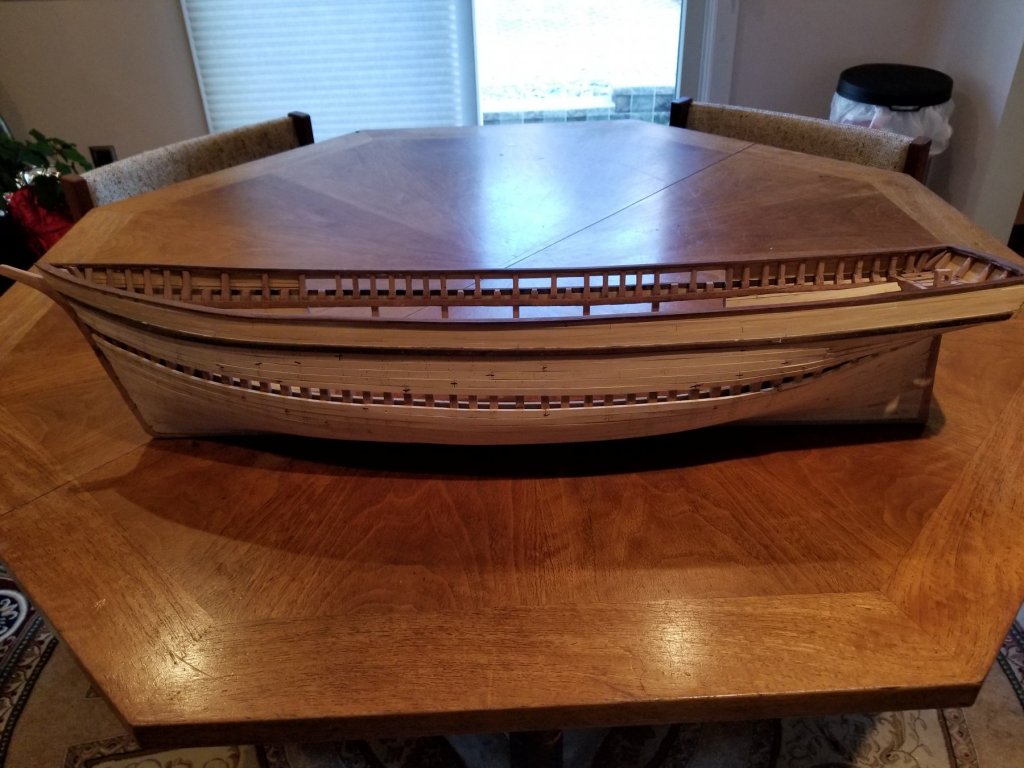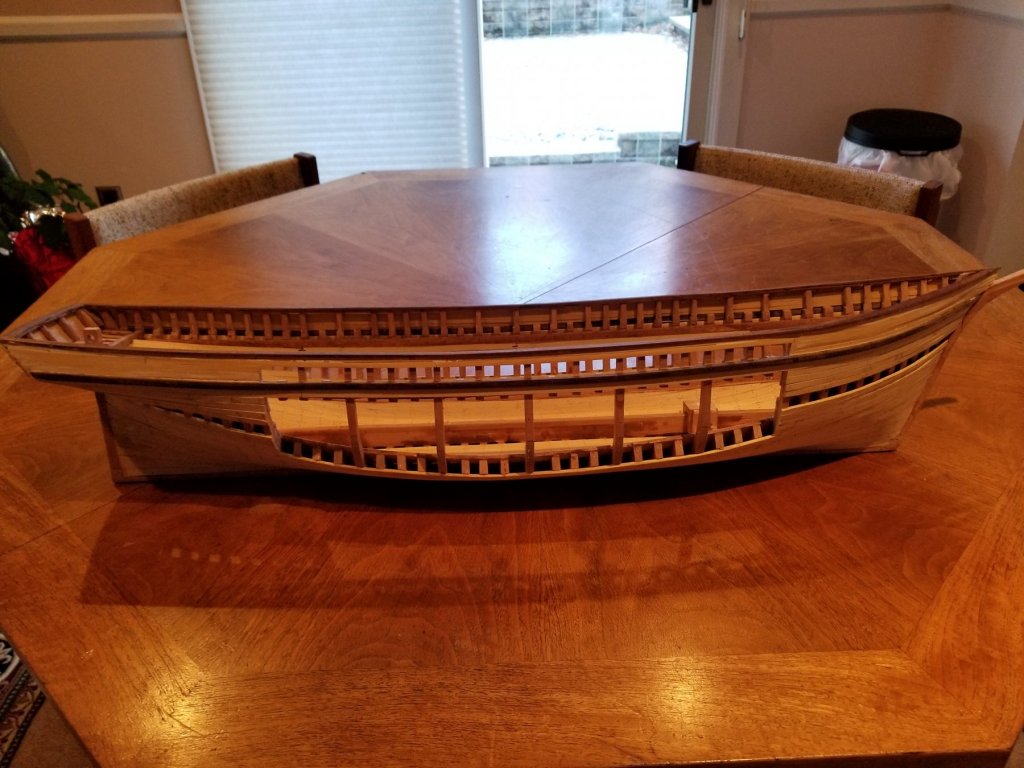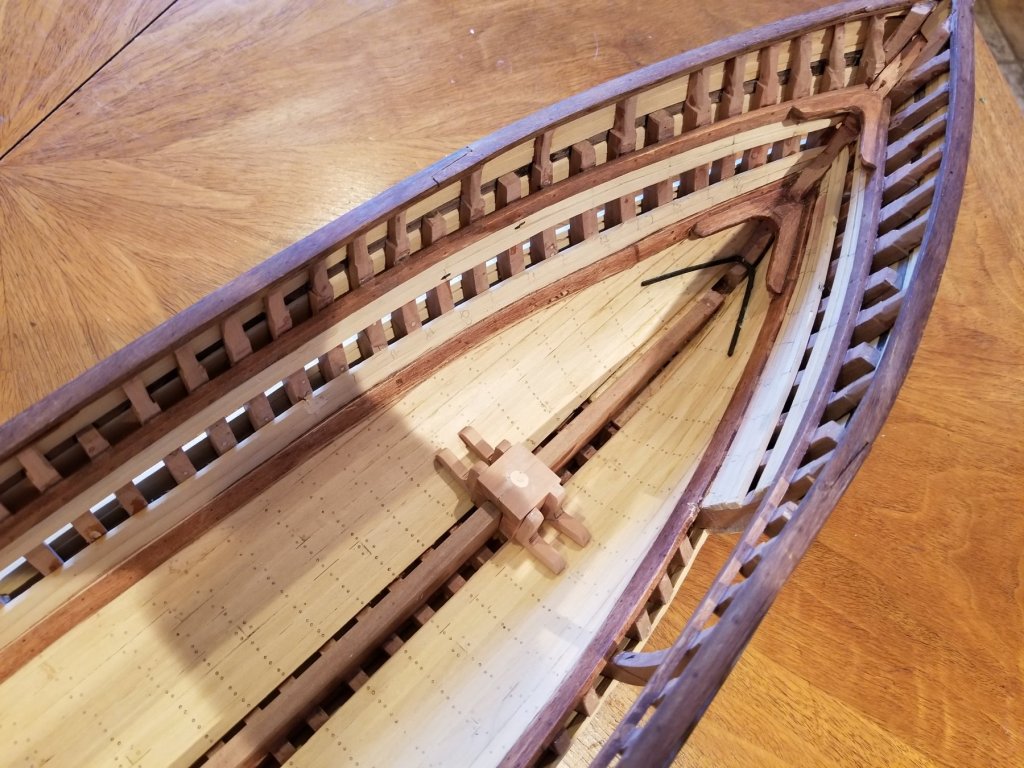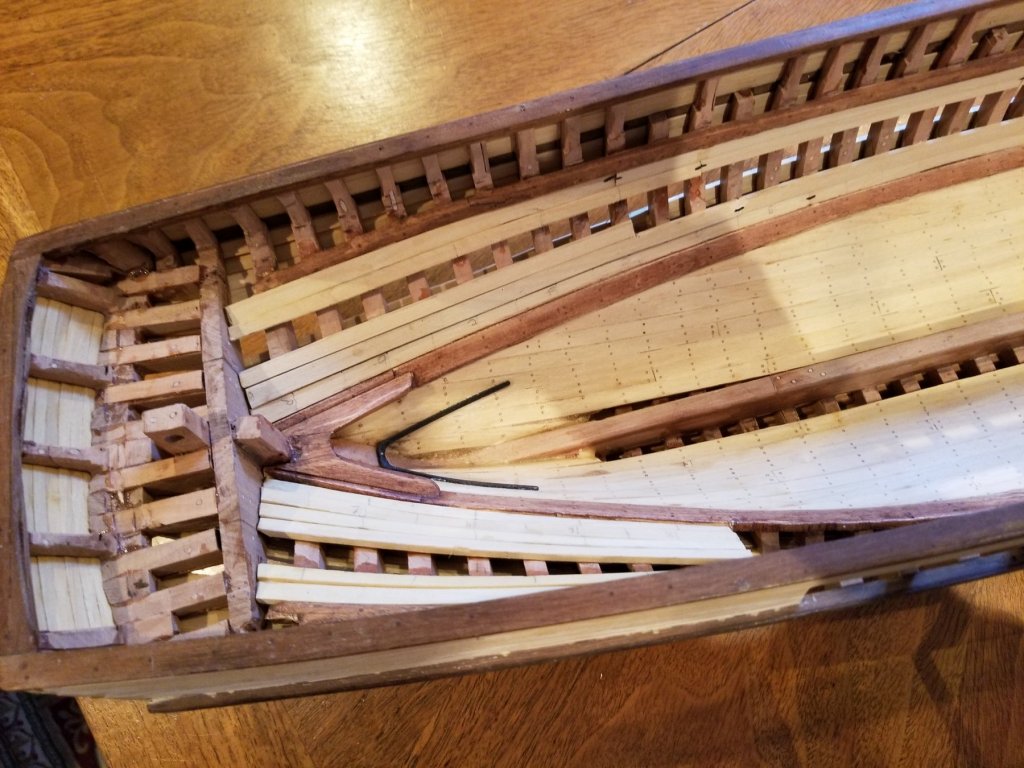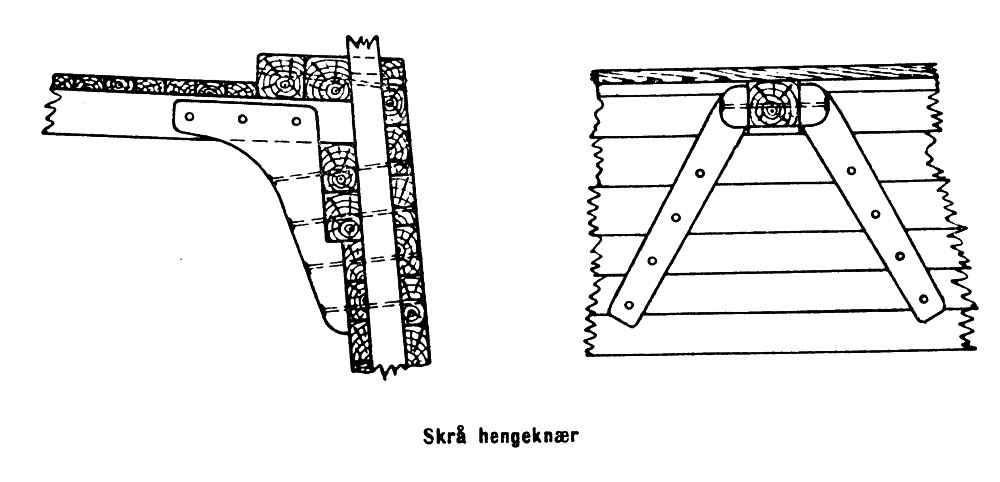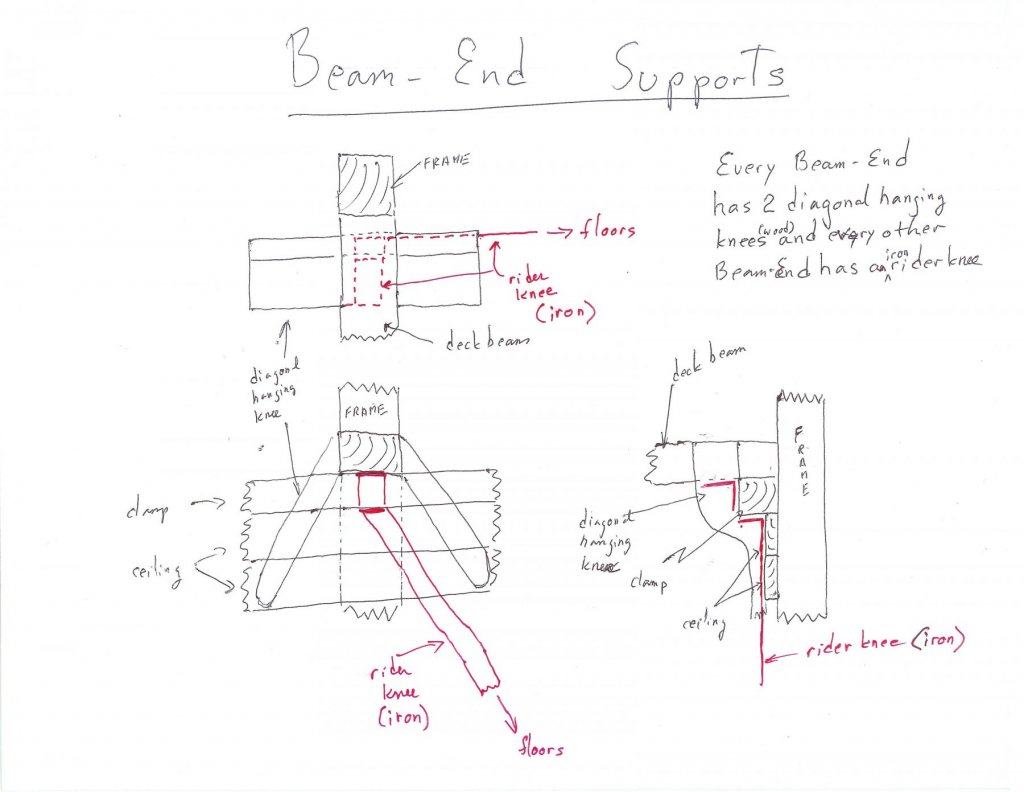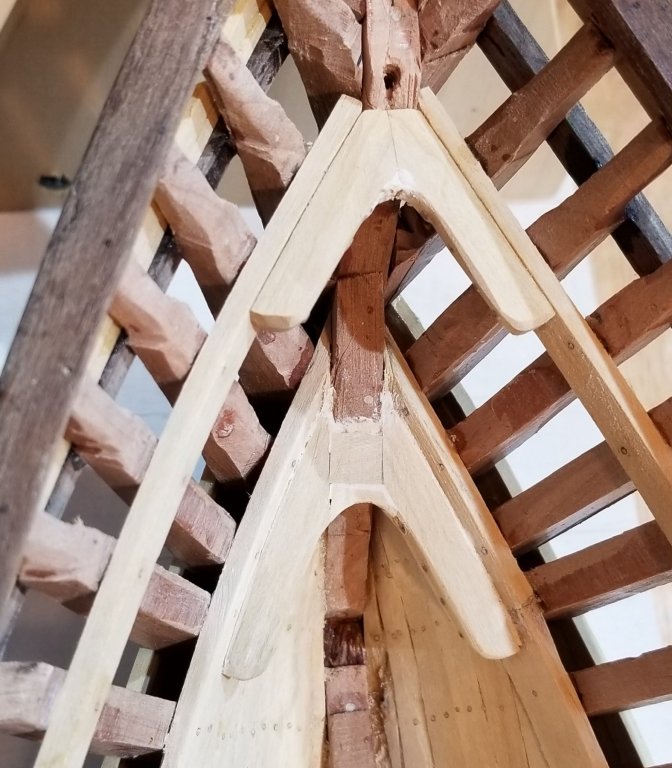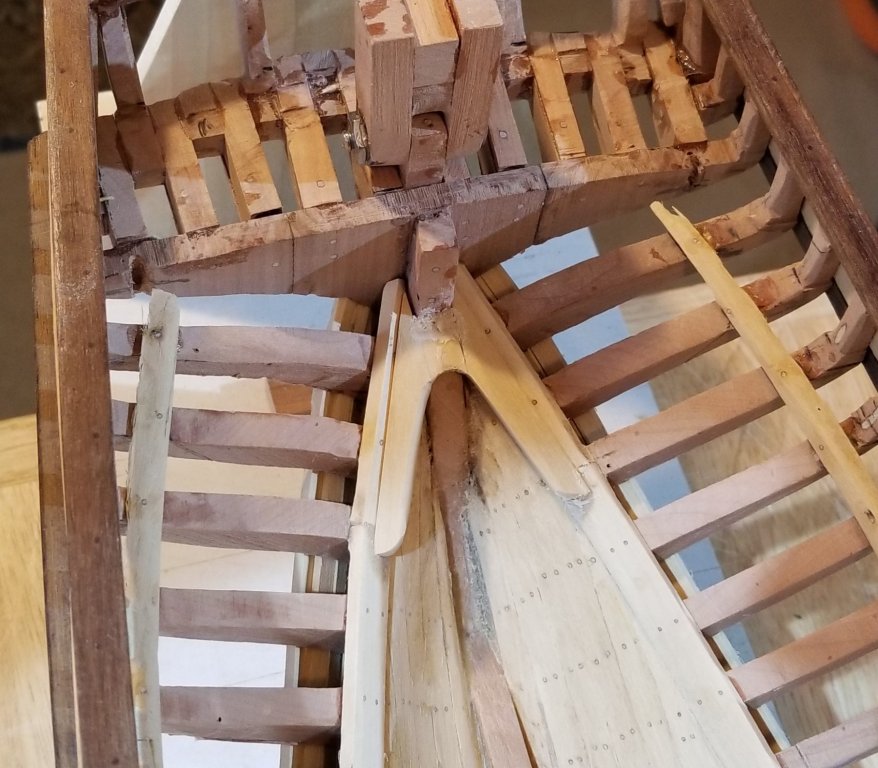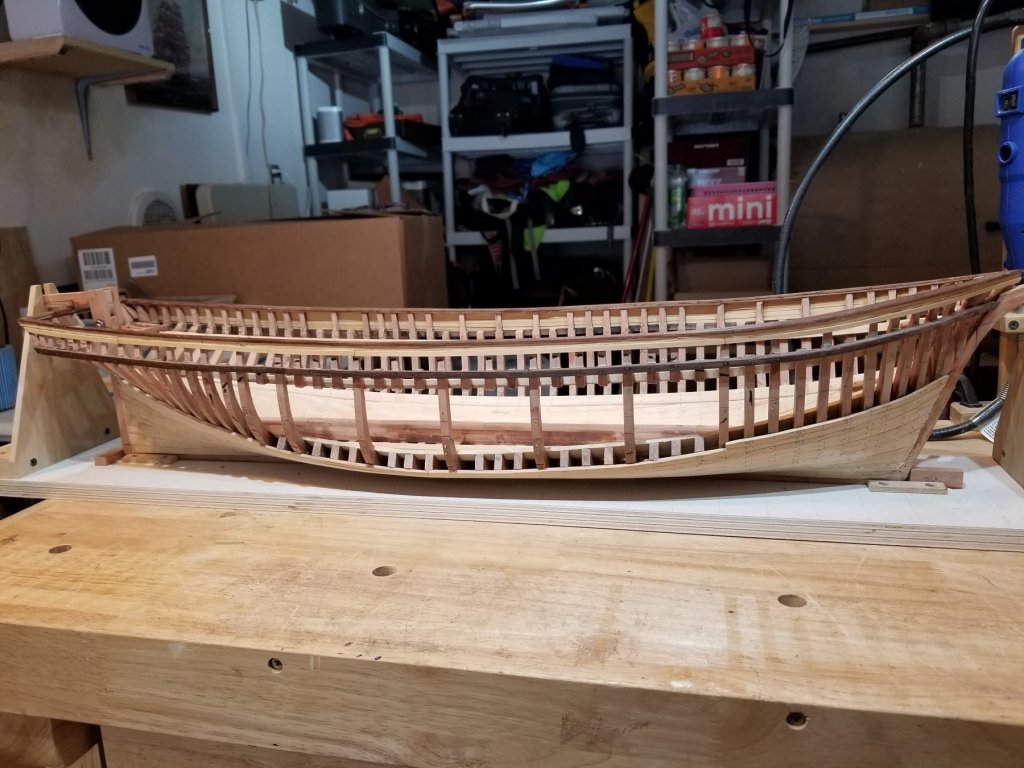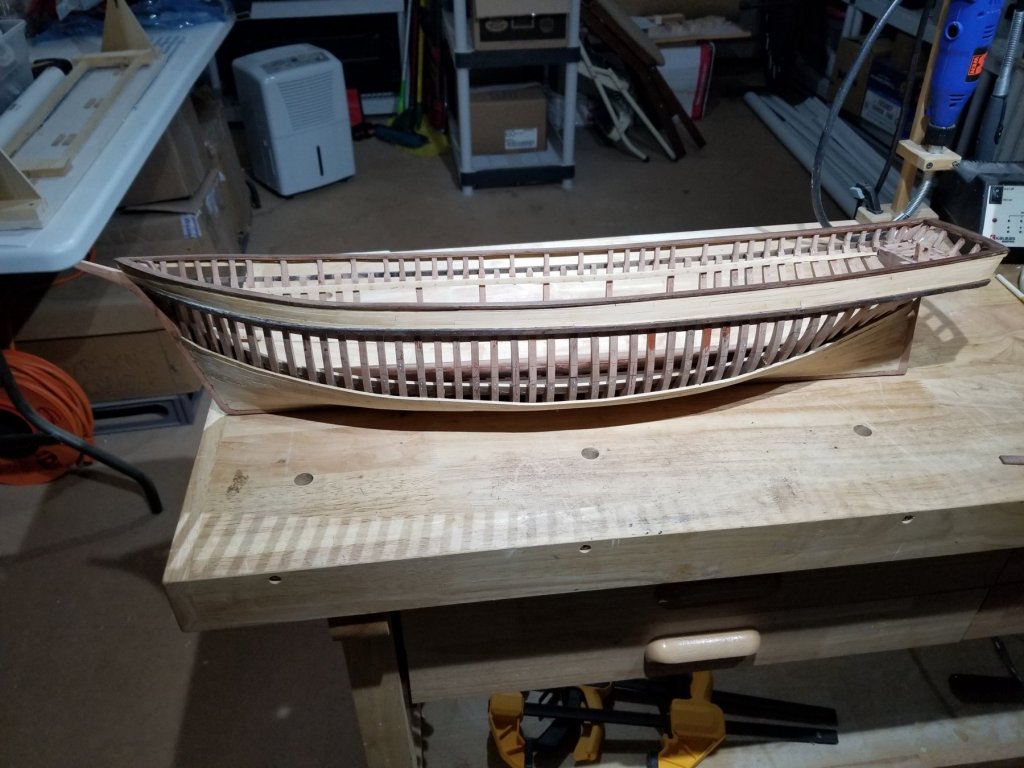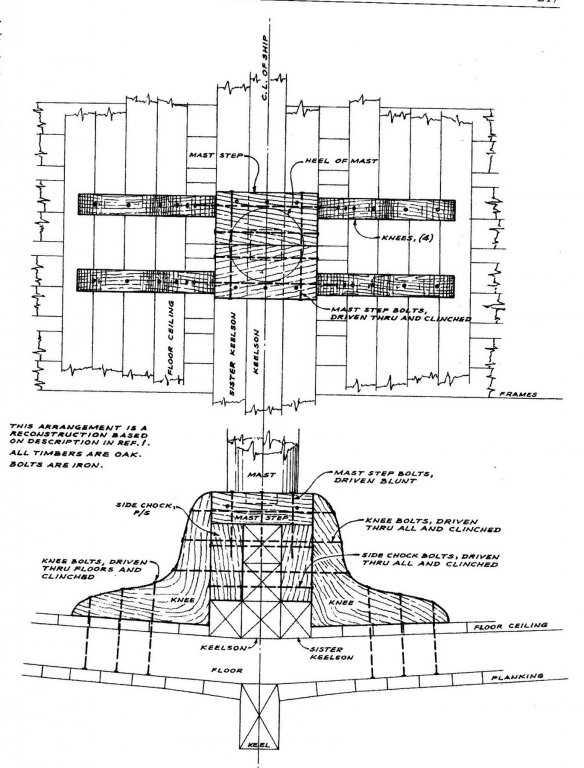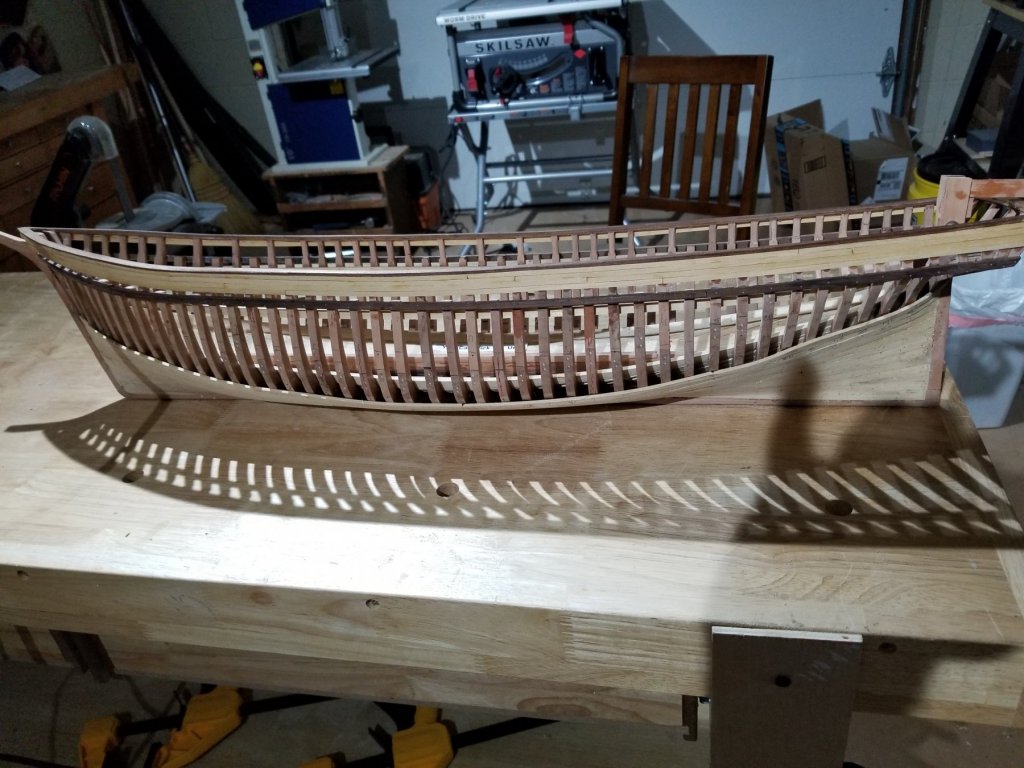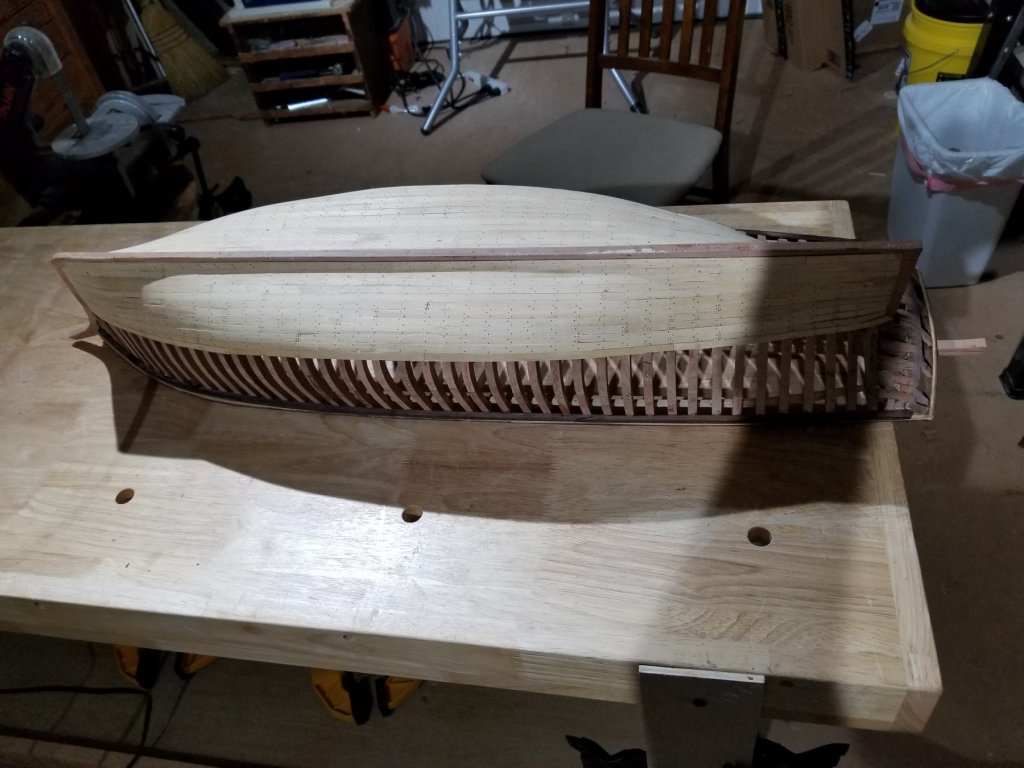
Doug McKenzie
NRG Member-
Posts
221 -
Joined
-
Last visited
Content Type
Profiles
Forums
Gallery
Events
Everything posted by Doug McKenzie
-
Once the fo'c'sle was nearly done, I realized that Leon probably didn't have a fo'c'sle for the crew, rather they probably bunked in the deck house. Before acting on this realization, I posed the question to another MSW forum under the topic, "Deck House versus Forecastle for Crew Quarters". A consensus was quickly reached that the crew was most likely quartered in the deckhouse. The question, of course, arises why did I think the crew was quartered in the fo'c'sle in the first place? My wife has the best answer - "You wanted to build a fo'c'sle so you just believed what you needed to". So the fo'c'sle has been removed from Leon and a separate little display shows "The Fo'c'sle That Never Was." The repaired Leon is shown with the little display in the two photos below. I made the shell of the hull for the little display out of 3x5 cards pressed into the inner surface of the bow and glued together. The next thing I'll be working on is the deck beams and their diagonal hanging knees which replace the more conventional lodging knees and hanging knees.
- 108 replies
-
- leon
- brigantine
-
(and 1 more)
Tagged with:
-
The fo'c'sle is nearly complete. The first picture shows the construction of the fo'c'sle bulkhead and a corner of the sole. This picture is taken at an odd angle in order to show the lumber hatch (aka, plank hatch, timber hatch). This is the slender rectangle on the starboard side just above the water line. This hatch could be opened to allow very long planks to be slid into the hold. Fortunately, it is clearly marked on the 1880 sheer plan. There is very little documentation on these hatches and how they opened but there are a number of photos of them being used. The second picture show the hold side of the bulkhead and the entire sole. An opening in the bulkhead is shown with the door held open upwards. When the lumber hatch was used the planks were passed through the fo'c'sle and out this opening in the bulkhead and into the hold. In the third picture the fo'c'sle is shown fully outfitted except for the coal stove and coal bucket which will be installed later. With no details available, a typical arrangement was used. Three bunks are provided with storage below and the two forward bunks have pipe berths above them. This seems consistent with the report that Leon had 8 crew members when she was lost in 1915. When the lumber hatch was used. the table and the two starboard bunks were moved out of the way. The original deck beams are thinner than Underhill's, As a result, the previously installed beam shelf/clamp is a little too low. A 1/32" strip was glued onto the previously installed beam shelf/clamp so that the deck level will be flush with the top of the wale. This strip is a lighter color than the previously installed beam shelf/clamp so it is clearly visible in all three pictures.
- 108 replies
-
- leon
- brigantine
-
(and 1 more)
Tagged with:
-
It's been awhile but progress has been made! Jeppe and I are reasonably sure now that we have the bulk of primary material that exists. So, now I'm in the process of incorporating the new material into the model itself. The first was to model the doubled frames of the original. This is important because of the 6 viewing windows which clearly show the framing. It took me awhile to figure out how to do this. The problem is that the model has 44 single frames sided at 12" while the original had 56 doubled frames sided (combined) at 18". What I finally decided to do was to match the portion of the original's 22" center to center which was wood (i.e 82% = 18" / 22"). Thus, the model's 30" center to center needs 24.6" of wood (= 30" x 82%). I actually achieved slightly less (24") by just doubling the 12" frames already in the model. The 5 doubled frames an be seen in the photo below. I still have to insert about 60 little stubs to mimic doubled framing where the frame cuts are visible. The two mast steps can also be seen. Sources were Crother's American Built ... in the 1850s, Tosti's Young America Vol 1 and numerous postings of Bob Cleek (thanks for the extended 'conversation', Bob). The fresh water tank is shown in the second picture. Sized at 750 gals, it will rise up just below the deck. I followed Tosti in modeling the tank and used both Tosti and Crothers to position it. There is almost no info on these tanks. As a result, I do not even know how they accessed the fresh water (plumbing pipes? pump with a hose? buckets?) Lastly, I've gone from flat varnish to low luster. The response from people who have seen both is very positive. I like it better too! Detail seems to stand out more clearly. Till next time, Doug
- 108 replies
-
- leon
- brigantine
-
(and 1 more)
Tagged with:
-
It turns out that what I thought was enuff fairing of the frames wasn't. So after cleaning that up I went to plank layout. I tried three different tapes to connect the dots and just couldn't make it work - I felt like my fingers were too big and kept getting in the way. So I decided to use wood battens. I had some 1/32" x 1/16" pieces and drilled holes for pins and then I was able to connect the dots and extend to the stem and stern post/transom. I only used these battens on every other plank. My endpoints were pretty different from Chuck's but, of course, it made sense to use his marks since I'll be using his planks!
-
Russ, I think there must be at least three phases of Leon's history the first would be as a Brigantine in presumably pretty good financial straits then as a Brigantine in not such good financial straits and then as a schooner in presumably pretty poor financial straits. The picture comes from the middle phase, of course. I have three questions about these phases: When was she cut down to a schooner? And was she a fore-after or did she have any square sails? Also when did she acquire her windmill pump, was it during the second phase or after she became a schooner? Im learning to just toss these questions out because sometimes there are interesting and useful responses! I would love to model the windmill pump if she had it as a brigantine because it is such an unusual piece of equipment!8 Doug
- 108 replies
-
- leon
- brigantine
-
(and 1 more)
Tagged with:
-
Oops - sorry I didn't answer all of your questions. I'm planning to make a fully sparred model (without sails) but my main interest is in the interior of the hull so who knows if I'll ever get to the rigging.
- 108 replies
-
- leon
- brigantine
-
(and 1 more)
Tagged with:
-
Matthias, I am not able to see a photo or a drawing when I go to Digital Museum website. All I see is the list of data items for Leon. Can you tell me what I'm doing wrong? I'm guessing that the photo is the one in Underhill's frontispiece because that is the only photo that I have ever seen of Leon - I would love to see another! I am definitely interested in the drawing since it may well be a new one to me. Also I hope your going to create a scratch-build blog for your project and I will follow your progress also. Thanks, Doug
- 108 replies
-
- leon
- brigantine
-
(and 1 more)
Tagged with:
-
The beveling of the frames is complete and was almost painless due to Ryland Craze's suggestion (in our email thread) to use nail files. I ended up with a set of emery boards that went from 80 to 3000. Similar to Ryland I used 180 almost exclusively. At first, I used a longitudinal motion using the bendability of the emery boards to advantage but I found that cumbersome so I made a change. I cut the emery board in half yielding 3 1/4" long pieces. Then I laid the short piece down (longitudinally) on the frame I was beveling and on an adjacent frame. I applied pressure to the frame I was beveling so the adjacent frame was only a guide. I rubbed along the frame's edge rather than moving longitudinally. I tried to leave a strip of the laser cut brown of about 25% of the thickness of the frame to avoid beveling too much. I think I may be trusting the accuracy of the kit by not beveling completely but it was a judgement call since the technology of the kit seems to be fantastic. I put extra effort into making sure each frame was centered when I glued them to the keel to further reduce this potential problem. Only after planking will I really know if this was OK.
-
The planking is now done (except for one transom plank) and the first pass at fairing is complete. I am reminded of my grandfather who watched ships being built in Maitland, Nova Scotia (also serving in the saw pits). He told me once that his favorite activity was watching the adzmen swarm over the hull after the planking was done. I personally don't find the fairing of the planking to be particularly interesting (the inside planking specifically) and even wondered if I could pay someone to do it! In any event, the lowest transom plank still awaits. The ends of the hull planking need to be cleaned up at the correct angle so that the last transom plank seals the ends of the hull planks. Underhill recommends using 1/4" wide plank (the rest of the transom planks ares 1/8" wide) so that the lowest transom plank will extend past the outer surface of the hull planks. Then, that lowest transom plank can be brought down flush with the outer surface of the hull planks. On the research side, Jeppe continues to locate useful documents. A newspaper article written about the last days of Leon reveals that "She was taking on too much water even though she had a windmill pump." We have to decide whether to model it or not. This depends on whether we are modelling a relatively new Leon or one with lots of years behind her and so more likely to have significant leaking. The original Sheer Plan (discussed in the previous posting) also has a curious rectangle in the bow just above the waterline. Jeppe realized that this is a lumber hatch which gives us certainty that she carried lumber - only a possibility before that. This also helps us define the position of the sole of the fo'c'sle since we know that the lumber passed through the fo'c'sle on it's way to the hold !
- 108 replies
-
- leon
- brigantine
-
(and 1 more)
Tagged with:
-
Surprises never cease. Jeppe in Norway has just found a newspaper article about Leon's last days when she took on too much water and sank with her load of coal in 1915. The article says that "she took on too much water even though she had a windmill pump" Apparently these windmill pumps were added to these ships as they aged and started leaking more. Another surprise (having nothing to do with windmill pumps) is that she had at least one lumber hatch in her bows for taking on very long timbers that would fit in the deck hatches easily. This shows up on the original sheer plan that Jeppe has located. This in turn establishes that she carried lumber which we suspected but didn't know for sure.
- 5 replies
-
- bilge pumps
- windmill pumps
-
(and 1 more)
Tagged with:
-
With the fo'c'sle on the horizon, it's time to revise Underhill's Deck Plan using our new information. The immediate object is to locate the fore-aft position of the after bulkhead for the fo'c'sle and to do this with confidence I want to make sure that the whole Deck Plan makes sense. I tried a couple of technique and they all bogged down and then I hit on this one. The first (top) drawing is the original Sheer Plan. It is pretty faint but on it Jeppe identified the 3 hatches, the two houses, both masts and the location of most of the deck beams. This drawing has been blown up to match the actual model. The second drawing is Underhill's Deck Plan . It is already at the model's scale. The third drawing is a copy of the second drawing with all the information of the deck layout cut out and replaced with plain white paper. The 'innards' of this drawing, having been cut out, was available to provide standalone pieces for deck items that can be positioned on the third drawing as indicated by the first drawing. Shown are the three hatches. Note the after hatch is smaller than Underhill's while the midship hatch is larger. The forward hatch is about the same size. All three hatchs had to be shifted forward about 3/4" (3'). The deck beams need to be added along with the partners. When all these items are sized and shifted I'll have a pretty good idea of where the companionway to the fo'c'sle is located hence where the after bulkhead of the fo'c'sle should be. I'm impressed by how closely Underhill's Deck Plan matches the original. I remember reading some time ago that in the same way running rigging was largely standardized so that different ships were very similar, that the deck plans evolved towards a kind of standard variations that did not affect the functionality. Underhill's closeness seems to support that observation.
- 108 replies
-
- leon
- brigantine
-
(and 1 more)
Tagged with:
-
This first post I'll mention some of the skills that I am hoping to hone: 1-- Fairing the frames - I would like to have more of a process to follow whereas I currently just sort of gently attack the frames - this is particularly true for the inside faces of the frames. 2-- Planking - Making a nice fit between the edges of adjacent planks. 3-- Painting - I have only once painted a model ship (Emma C Berry for sailing). The finish that I obtained was crude to say the least. 4-- Others - I'm sure there are skills that I don't even anticipate needing now. The photo shows current status - frames are being faired BTW this kit is great! Pieces are well designed and manufactured at least up to where I am now. The inclusion of the building board is much appreciated. Doug
-
Druxey - exactly, which is presumably why the arrangement was required by the DNV when there were no lodging knees at beam-end. Doug
- 6 replies
-
- rider knees
- lodging knees
-
(and 2 more)
Tagged with:
-
Two strakes to go both inside and outside and the (rough) planking will be done - lots of fairing in my future. The iron breast hooks are in and the foremast step is nearly done but not actually installed yet. The next significant project (beyond fairing) is going to be the fo'c'sle which kind of hangs below the deck. I'll outfit it to some extent ( 2 bunks with lockers below, 2 folding pipe berths, a mess table and a stove) and somehow make it all visible. Underhill has no vent for a stove but Leon being built in Norway just had to of had some heat for the crew. The reason I'm not going to tackle the deck beams, diagonal hanging knees and rider knees yet is because I want as much access to the bow as possible. I'll have to put in a few deck beams up forward but that won't be the focus of the effort. Jeppe Jul Nielsen is going to be posting all of the information that we have found about Leon on his website. When he decides what the URL will be I'll post it
- 108 replies
-
- leon
- brigantine
-
(and 1 more)
Tagged with:
-
Pat,and Jersey City Frank Pat, I got the book but Plates 6 and 7 are not in it rather only the descriptions of those two plates is included. If you can help me on this I should would appreciate it! PS I enjoy the 2 part book - Part 1 Naval architecture and Part 2 Building a ship. The good news is that I have a diagram (attached) from Norway (courtesy of Jeppe Jul Nielsen) of the diagonal hanging knees that are mentioned in both the DNV survey for Leon and the 1882 DNV Rules and Regulations. They are pretty much exactly as my drawing shows so that was encouraging. And yes Jersey City Frank, I'm thinking this is pretty strong. The interesting thing is that it is referenced in the 1882 DNV Rules and Regulations as a required arrangement for single deck vessels without lodging knees on the beams. Thanks,guys, Doug
- 6 replies
-
- rider knees
- lodging knees
-
(and 2 more)
Tagged with:
-
I have some excellent info from two sources on how the brigantine Leon's deck beams were fastened to the hull. She was built in Norway in 1880 and classed by DNV. One source is an 1880 DNV survey and the other is the 1882 DNV Rules and Regulations for classification. I have come up with a diagram of a possibility that seems to fit with both sources but it is sufficiently unusual (to me) that I want to share it with others to see if it seems plausible. But first the info: 1880 Survey: - This survey was translated from Norwegian to English by Jeppe Jul Nielsen in September 2018 "Deck beams are fastened with 2 diagonal hanging knees" "Hanging knees ... 45 on each side; arms 2 1/2' to 3 1/2'. Legs 4 1/2' to 5' made of spruce". [Since there are 25 deck beams, this squares with 2 hanging knees at each beam-end] "Knee riders; 11 on each side from clamp to floor" [This implies a knee rider at every other beam, more or less] 1882 Rules and Regulations "All deck beams to be securely fastened to the sides of the vessel by knees, either hanging or lodging..." [Use of 'hanging or lodging' was unexpected since both seem to be common in America.] "When the knees are fastened to the sides of the beams, [emphasis is in the original] If they are lodging knees [criteria is then given for when you need 1 knee per beam-end versus 2] If they are hanging knees, two knees at each beam-end." "If the beams in single-decked vessels [Leon is single-decked] are fastened with lodging-knees, or with a shelf, the following additional knees shall be placed under those beams. In vessels of 250 tons [Leon was 302 tons] and upwards, a knee-rider at every beam-end for every other beam. The riders must be of sufficient length to admit of their being bolted into the floors with one bolt or two. If the hanging knees are of wood, {Leon's were spruce] instead of knee-riders without a knee are to be used, the upper end of which shall reach up to the upper strake of the clamps." I should also mention that Underhill shows no lodging knees for the deck beams except at carlings, the partners and some bitts - none attaching the beams to the hull. I'll certainly appreciate any comment that you folks may have. Doug
- 6 replies
-
- rider knees
- lodging knees
-
(and 2 more)
Tagged with:
-
Well Bob, clearly two built-up steps are in order. Particularly convincing is the yacht's built up step - if any designer/builder creates that step for a yacht there is little chance that a large fore-aft mast would get less. I think that built-up steps scaled to the mast's diameter seems like a reasonable way to go. Thanks for fascinating insight. Doug
-
Bob, When I asked my question I never dreamed that I would get so much information and perspective in return. My thanks are hearty and I would love your impression of a two part proposal of mine based largely on your response. As you most likely know I am am exposing the interior of Leon in my model. Accuracy is of course the major issue. but where certainty is not possible, informed judgement is next best so part one of my two part proposal is that the square rigged foremast gets the built up step based on your informed judgement. Regarding the fore-aft rigged mainmast - if we cannot make a judgement that it also should get a built up step (either because it's stresses would warrant one or because it was common practice (?) to make all mast steps in one vessel the same type) then I would vote (i.e. the second part of the proposal) for using the simple step for the reason of displaying variety to the viewer. Speaking for myself before embarking on this research effort I had no idea that a built up step was ever used. Seeing the two types in one ship would drive this point home beautifully to every viewer I think. Thanks again, Doug PS I don't know if you've seen Leon's blog in the scratch built forum but if not it might be of interest to put this specific question into a larger context.
-
Folks, 2 hooks have been fitted in the bow and 1 in the stern. 2 more hook needs to be fitted in the bow and 1 in the stern after I finish the ceiling planking. Jeppe Jul Nielsen is gradually translating the 1880 DNV survey. I am so grateful to Jeppe for his research and translation skills (and his willingness to use them!). He has found that Leon had 4 hooks in the bow and 2 in the stern with the lowest one in both places being made of iron. I am putting the 4 wooden hooks in and will do the iron hooks when I receive some brass strips that I've ordered. The survey says they are both 2.5" x 3.5" which I believe means that they are made out of 2.5" x 3.5" iron bar (roughly 1/16" x 1/16" on the model). Jeppe has also found that there were 25 deck beams 10" x 11.5", The hold pillars (4" x 10" pine) were fitted to every other deck beam. We are surprised that the pillars do not have a square cross section since a number of other ships of similar size as Leon have 9" x 9" cross section. I've also cut out quite a few frames on the right side to make the inside clearly visible - this, of course, is why all the research has been done, i.e. to determine what the inside actually looked like!. I'll apologize for right rather than starboard but small boat sailing with a lot of folks unfamiliar with ship jargon made the switch necessary and permanent. I've included a photo of the left side also because the raw bulwark planking is done and for some reason I think it is just plain beautiful. 'Till next time Doug
- 108 replies
-
- leon
- brigantine
-
(and 1 more)
Tagged with:
-
Duff and Bob, I think we are allowed to question Underhill on this detail because I do not believe he knew what the specific internal details were for Leon. I believe he goes with usual practice or such. I'll give an example, we now know that Leon had four hooks forward (3 of wood and 1 of iron) and 2 aft (1 of wood and 1 of iron), which seems a lot for a relatively small ship, but Underhill only mentions one forward joining the beam shelves. We now have a DNV survey from 1880 which is gradually being translated from Norwegian to English so for structural information we should be in pretty good shape. Bob, it is interesting to me that you imply that Leon is a pretty good sized ship. I've always thought of her as being small. Oh, btw, when you say mainmast, I assume you mean the square rigged foremast. I don't quite know how to ask this, Bob, but can you give me any info on how you make the judgement that "given her size, I'd have expected that she'd have a properly built step."
-
Another question regarding brigantine Leon, 1880, Norway. 302 tons. What kind of mast step was she likely to have had? I am learning that there is very little information on this subject. There are three representations of mast steps that I have encountered - they all have a square tenon at the bottom of the mast: 1-- The first is that a square mortise in the keelson receives the tenon on the mast. 2-- The second says that they never cut the mortise directly in the keelson but rather in a thick block which is bolted to the keelson. Sometimes an iron fixture might have been used. 3-- A much more complicated arrangement shown in the attached diagram is given as the most common arrangement designed to spread both the weight of the mast and the stresses over a larger area.. Considerations which make sense to me are that Leon being a relatively small ship might not have needed the complex arrangement. And further when she carried coal it would make getting the coal out a little more bothersome. Any thoughts would be very welcome. Thanks, Doug PS the diagram comes from Crothers, American Built Packet and Freighters in the 1850s
-
To those who have been following this story of Leon, I apologise for the long absence of any posts. The reason is that I've only done a little on her (more bottom planking and some bulwark planking - pictures attached) as I've been spending my time on research. It is not complete yet but we are closing in so I thought folks might be interested in some of the results. Lloyd's never classed Leon so they have no information on her except for a few sightings in their Register. Lloyd's has kept their surveys back to 1757 and they are now being digitized which may be completed in January 2019. Leon rather was classed by Det Norske Veritas, the Norwegian classification society. Unfortunately, DNV has not saved its surveys. That's all the bad news. The good news starts with the Laurvik (now Larvik) Museum - this is the city where Leon was built. We learn that Leon's designer/builder is no longer 'unknown' - It is Colin Archer, a well known and well respected Norwegian designer/builder. I should say here that a number of people have helped the unraveling of Leon's story and I will credit these folks in the future when I write-up the research effort. For now, just some of the results, miscellaneous information that has emerged - Her shrouds were rope and her stays were wire, Her hanging knees were iron and her lodging knees were wood. Original lines plans have been located and there are noticeable differences from Underhill's plans. I'm currently developing a comparison exhibit to show these differences. The original lines plans are a little difficult to read. They are given in a book by Tor Borsch Sanns, Colin Archer's Ships, however, this book has not been translated into English. The last item is that in the Norwegian Maritime Museum an 1880 DNV survey of Leon has been found. Some folks are now trying to translate it from the Old Norwegian that it is written in to English but the task is difficult. The survey is basically a long list of printed nautical terminology with handwritten measurements and notes. Translating the nautical terminology is challenging. So that's where we stand and I certainly hope that translating the survey is fruitful as that will supply us with a wealth of construction details,
- 108 replies
-
- leon
- brigantine
-
(and 1 more)
Tagged with:
-
Folks, It's been a while since I've posted but I think I've pretty much exhausted my possible sources. I'd already mentioned that Lloyd's never classed Leon so they never surveyed her although Lloyd's register has a number of entries for her with some technical info as Russ has pointed out. Leon was classed with Det Norsk Veritas (DNV) - the classification society in Norway. Unfortunately A fellow there said that because she was a pretty standard little ship with no fame or notoriety he figured that DNV would not have any survey info (or any other info) archived . Apparently DNV only archive info on well known ships. The only remaining source that I'm aware of is Merseyside Maritime Museum where an outfit Martime Archives (I think) does most of their research but it is temporarily not available and there is no ready date so.... I think I'll just continue with using NRG MSW and other data. I just remembered I'm also trying to get DNV requirements in 1880. Thanks enormously for all the ideas and support. I'll be back\ Doug
-
Tim, Thanks veru much for the fne photos. The detail on the houses and rigging is going to be helpful. Also, her pale appearance convinces me that I'm going to stain her hull!
- 108 replies
-
- leon
- brigantine
-
(and 1 more)
Tagged with:
About us
Modelshipworld - Advancing Ship Modeling through Research
SSL Secured
Your security is important for us so this Website is SSL-Secured
NRG Mailing Address
Nautical Research Guild
237 South Lincoln Street
Westmont IL, 60559-1917
Model Ship World ® and the MSW logo are Registered Trademarks, and belong to the Nautical Research Guild (United States Patent and Trademark Office: No. 6,929,264 & No. 6,929,274, registered Dec. 20, 2022)
Helpful Links
About the NRG
If you enjoy building ship models that are historically accurate as well as beautiful, then The Nautical Research Guild (NRG) is just right for you.
The Guild is a non-profit educational organization whose mission is to “Advance Ship Modeling Through Research”. We provide support to our members in their efforts to raise the quality of their model ships.
The Nautical Research Guild has published our world-renowned quarterly magazine, The Nautical Research Journal, since 1955. The pages of the Journal are full of articles by accomplished ship modelers who show you how they create those exquisite details on their models, and by maritime historians who show you the correct details to build. The Journal is available in both print and digital editions. Go to the NRG web site (www.thenrg.org) to download a complimentary digital copy of the Journal. The NRG also publishes plan sets, books and compilations of back issues of the Journal and the former Ships in Scale and Model Ship Builder magazines.

